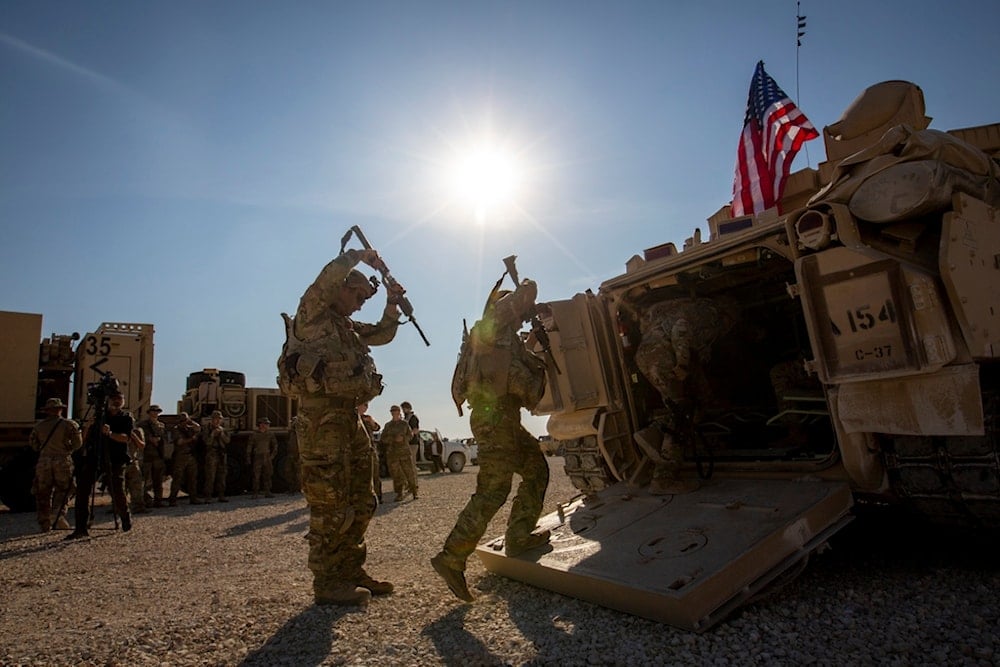US shifts Syria strategy to curb Iran, not rebuild nation: WashPo
While traditional justifications for US deployments have centered on counterterrorism, officials are becoming increasingly transparent about their true priorities.
-

Crewmen enter Bradley fighting vehicles at a US military base at an undisclosed location in Northeastern Syria, on Nov. 11, 2019 (AP)
The United States is recalibrating its military footprint in Syria, not to stabilize the country or support post-conflict reconstruction, but to strategically constrain Iran's regional influence, according to a report by The Washington Post on Thursday.
Multiple US officials confirmed that the Trump administration has no plans for a full withdrawal. Instead, the emphasis is on reducing and consolidating forces to maintain key leverage points along critical corridors they claimed are being used by Iran and its allies. "Stuff is already moving, although they [the Trump administration] likely won't announce anything before the Iran talks," one US defense official said. He confirmed that military planning is already underway to "reduce" and "consolidate" American forces in Syria.
While traditional justifications for US deployments have centered on alleged counterterrorism, officials are becoming increasingly transparent about their true priorities. "We're not necessarily looking at saving Syria for the Syrian population," a US official stated. "We're looking at Iran not coming back and the Islamic State terror group not coming back as the crucial interest of the American people there."
The troop adjustments, reported by CBS News, involve scaling down the 2,000-strong force and concentrating remaining personnel at fewer bases.
US troops have begun exiting the Koniko gas field base in Deir ez-Zor, with convoys of 70 and 200 vehicles reportedly heading toward Erbil in northern Iraq, according to Al-Araby Al-Jadeed.
Strategic Repositioning
The Washington Post report was released hours after Israeli media reported growing alarm in Tel Aviv over the expected US adjustments. According to Yedioth Ahronoth, Israeli officials had already been notified of the plans and had tried unsuccessfully to persuade Washington to reverse course.
According to the Israeli outlet, security officials in Tel Aviv are concerned that the drawdown could lead to a power vacuum in northeastern Syria—one that Turkey might exploit. In particular, Israeli authorities warned that Turkish control over military installations such as the T4 airbase or Palmyra would cross red lines and threaten their operational freedom along the northern front.
Read more: 'Israel' needs to adapt to Turkey’s influence in Syria: Israeli media
On December 8, 2024, Damascus fell to armed opposition forces, leading to the resignation and exile of President Bashar Assad. In January, Ahmed Sharaa assumed the role of transitional president under a new administration.
The US repositioning cannot be understood in isolation. It aligns with Washington's broader regional posture, which includes massive arms transfers to "Israel" in preparation for a possible confrontation with Iran. Recent shipments of bunker-buster bombs, JDAM kits, and THAAD missile systems reinforce the US-Israeli axis as nuclear diplomacy falters. A senior US official told The Washington Post that the timing of the drawdown announcements is being coordinated around ongoing indirect negotiations with Iran, currently awaiting Omani facilitation.
In this context, Syria serves less as a battleground against terrorism and more as a strategic chessboard in the struggle to deny Iran territorial continuity from Tehran to the Mediterranean. The shifting US footprint is not a drawdown in intent—only in form.

 3 Min Read
3 Min Read








